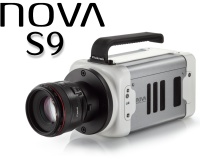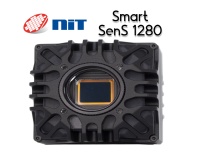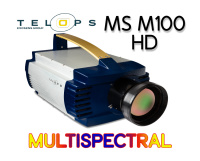- Description
- Specifications
- Videos
In the field of infrared technology, the Telops Fast M100HD MWIR thermal imaging camera is unique due to its unmatched performance and adaptability for a range of uses. With its remarkable 100 Hz full-frame rate at 1280 x 1024 pixels, the camera makes sure that even the tiniest temperature changes are clearly recorded. Its 30 mK thermal sensitivity allows scientists to detect even the slightest temperature fluctuations. Thermal fingerprints are captured in a wide range of applications by the broad spectral range of 1.5 μm to 5.4 μm or optionally 3.0 to 5.0 μm.
The Fast M100 HD incorporates sophisticated calibration techniques that ensure radiometric accuracy from the moment the camera is powered on. This permanent automatic calibration eliminates the need for manual adjustments, providing consistent and reliable measurements across various operating conditions. Additionally, the camera features advanced image processing algorithms that enhance image quality in real-time, improving visibility in low-light scenarios and ensuring that critical details are not lost.
This performance is provided by the IP67-rated enclosure of the Fast M100 HD, which can withstand harsh field temperatures ranging from -15°C to +50°C. Its sturdy yet small design maintains portability without sacrificing durability or stability.
High-speed infrared imaging technology has advanced significantly with the Telops Fast M100 HD MWIR thermal camera. Its remarkable frame rates, high sensitivity, and sturdy build make it ideal for a variety of uses, including material testing, combustion investigations, ballistics, and aeronautical research. The Fast M100 HD stands out as a leading solution as industries continue to demand more accurate and dependable thermal analysis, enabling engineers and researchers to push the envelope of innovation.
The Fast M100 HD is not just strong but also accessible to users of all skill levels thanks to its intuitive interface and sophisticated data management features. The Fast M100HD is still at the forefront of thermal imaging as technology advances, providing experts in the field with unmatched performance and dependability.
Target applications include:
- Experimental Mechanics
- Non-destructive Testing
- IR Signature Measurement
- Heat Transfer Testing
- Tensile Testing
| 1280 x 1024 pixels | |
| 1G, 16G, or 32GB | |
|
Key Features That Set the FAST M100 HD Apart
|
|
|
|
|
| 100 Hz Full Frame/ 1,200 Hz @64 x 4 | |
| 1.5 – 5.4 μm (3.0-5.4μm OPT) | |
| Cooled InSb | |
| 10 μm | |
| 321 × 199 × 176 mm | |
| Subwindow Mode | |
| GigE, Camera Link, HD-SDI | |
| 4 filters | |
| GPS, IRIG-B |
Related products
How To Choose Your MWIR Infrared Camera
When it comes to selecting the right mid-wave infrared (MWIR) camera for your specific needs, understanding the technology and its applications is crucial. MWIR cameras are powerful tools that capture thermal images in the 3 to 5 micrometer wavelength range, making them ideal for various applications, including industrial inspections, scientific research, and defense surveillance. This guide will walk you through the essential factors to consider when choosing an MWIR camera, ensuring you make an informed decision.
What is MWIR?
Mid-wave infrared technology refers to the imaging capabilities that operate within the 3 to 5 micrometer range of the infrared spectrum. This range is particularly effective for detecting thermal radiation emitted by objects at moderate temperatures. MWIR cameras are designed to capture this thermal energy, converting it into visual images that can be analyzed for various applications.
How MWIR Cameras Work
MWIR cameras utilize a combination of lenses, thermal sensors, and processing electronics to create thermal images. The lens focuses infrared radiation onto the detector, which is typically an array of pixels. These detectors can vary in resolution, with common configurations being 320x256 and 640x512 pixels. The thermal energy absorbed by the detector is then converted into an electronic signal, which is processed to produce a visual representation of the thermal scene.
Advantages of MWIR Cameras
- Sensitivity: MWIR cameras are known for their high sensitivity, allowing them to detect subtle temperature differences in a scene. This is particularly beneficial for applications requiring precise thermal measurements.
- Versatility: These cameras can be used across various industries, including manufacturing, environmental monitoring, and military applications, making them a versatile choice for many users.
- Image Quality: The ability to capture detailed thermal images enables users to identify issues that may not be visible in the visible spectrum, such as heat leaks in buildings or overheating machinery.
Key Considerations When Choosing an MWIR Camera
1. Application Requirements
Before selecting an MWIR camera, it's essential to define the specific application for which it will be used. Different applications may require different features and capabilities. For instance:
- Industrial Inspections: If the camera will be used for detecting heat loss in buildings or monitoring machinery, high sensitivity and resolution are critical.
- Scientific Research: Researchers may need cameras with advanced features such as multispectral imaging or high dynamic range capabilities to capture a broader range of data.
- Defense Surveillance: In military applications, the ability to detect and identify targets at long distances is paramount, necessitating high-resolution imaging and fast frame rates.
2. Resolution and Sensitivity
The resolution of an MWIR camera determines the level of detail that can be captured in thermal images. Higher resolution cameras can provide more detailed images, which is crucial for applications requiring precise measurements. Additionally, sensitivity, often measured as Noise Equivalent Differential Temperature (NEDT), indicates the camera's ability to detect small temperature differences. A lower NEDT value signifies better performance, especially in applications where subtle temperature variations are critical.
3. Cooling Requirements
MWIR cameras can be categorized into two types based on their cooling requirements: cooled and uncooled. Cooled MWIR cameras typically require cryogenic cooling to operate effectively, which enhances their sensitivity but adds complexity and cost. Uncooled MWIR cameras, on the other hand, can operate at ambient temperatures, making them more compact and easier to use. When choosing a camera, consider the trade-offs between sensitivity and operational simplicity.
4. Environmental Conditions
The environment in which the MWIR camera will be used plays a significant role in the selection process. Factors such as temperature extremes, humidity, and exposure to dust or moisture can impact camera performance. Ensure that the chosen camera is rated for the specific environmental conditions it will encounter.
5. Budget Constraints
Cost is always a consideration when selecting any technology. MWIR cameras can vary significantly in price based on their features and capabilities. It's essential to balance your budget with the required specifications to ensure you get the best value for your investment. Consider not only the initial purchase price but also the long-term operational costs, including maintenance and potential upgrades.
Exploring Telops MWIR Camera Solutions
Overview of Telops
Telops is a recognized leader in the field of mid-wave infrared imaging technology, offering a range of innovative solutions tailored to meet diverse customer needs. Their MWIR cameras are designed with advanced features that enhance performance and usability across various applications.
Key Features of Telops MWIR Cameras
- High-Speed Imaging: Telops cameras are equipped with advanced imaging capabilities that allow for super high-speed thermal imaging, making them ideal for dynamic environments.
- Radiometric Calibration: Many Telops models feature proprietary radiometric calibration, enabling automatic exposure time adjustments for optimal image quality.
- Multispectral and High Dynamic Range: Telops cameras can capture images across multiple spectral bands, providing users with a comprehensive view of thermal data.
Popular Models
- Telops FAST Camera Series: This series is designed for high-speed applications, offering rapid frame rates and exceptional sensitivity, making it suitable for industrial and scientific research.
- Telops Radia: The Radia series is known for its versatility and reliability, providing users with robust thermal imaging solutions for various applications.
- Radia M100: This model is particularly well-suited for applications requiring high-resolution imaging and advanced thermal analysis capabilities.
Applications of MWIR Cameras
Industrial Applications
MWIR cameras are widely used in industrial settings for applications such as predictive maintenance, quality control, and process monitoring. By detecting temperature anomalies, these cameras can help prevent equipment failures and improve operational efficiency.
Environmental Monitoring
In environmental science, MWIR cameras play a crucial role in monitoring temperature variations in ecosystems, detecting gas leaks, and assessing the health of vegetation. Their ability to capture thermal data in real-time allows researchers to make informed decisions regarding environmental management.
Defense and Security
The military and security sectors utilize MWIR cameras for surveillance, target acquisition, and reconnaissance. Their high sensitivity and ability to operate in low-light conditions make them invaluable tools for ensuring safety and security.
Learn more on our Application Fields of Infrared Thermography for MWIR Cameras
Export Disclaimer: Some goods on this site may be subject to US Export Regulations. Buyer agrees as one of the terms of purchase not to export such goods without having obtained and executed proper export licenses from the United States Government. Learn more.






